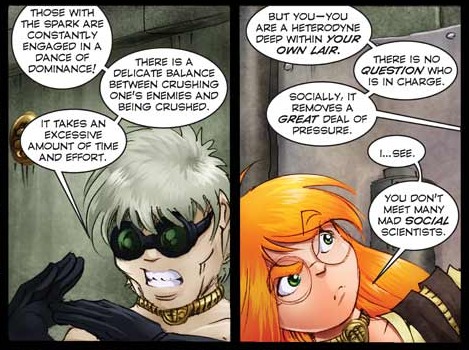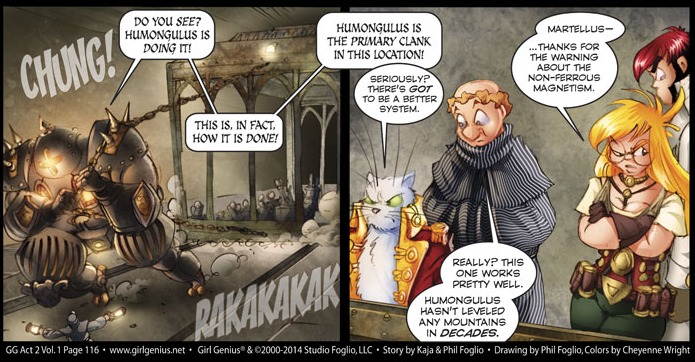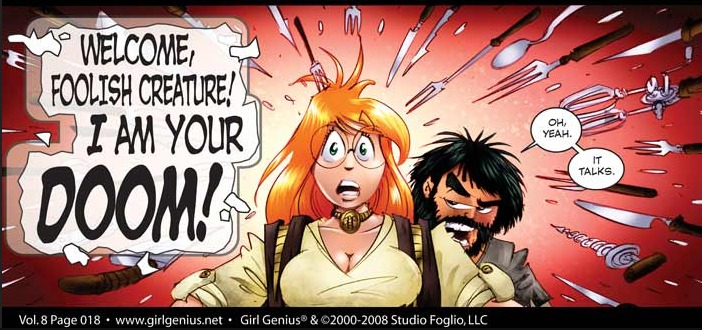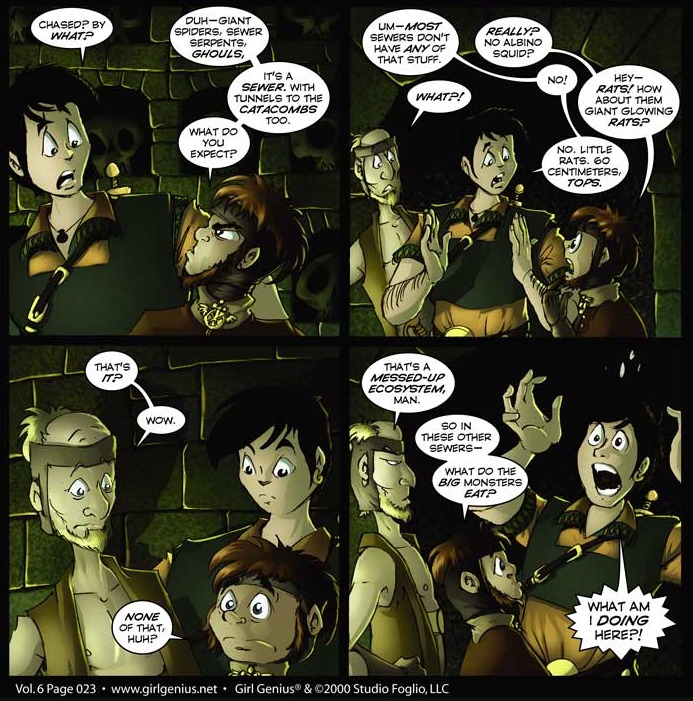Girl Genius is a long-running, multi-award winning webcomic about “Adventure, Romance, and Mad Science!” written and illustrated by Phil and Kaja Foglio. You might know those names if you ever played with old Magic: the Gathering Cards or ever opened old issues of Dragon, Dungeon, or Pyramid magazines, among others. So, you know, it was only a matter of time before they did an RPG supplement. This particular supplement had actually been in the works for quite a long time: anecdotally, I remember hearing rumblings about it at least ten years before it came out.
Before I dive further in though I want to talk a bit about the comic’s setting, and the common criticisms of of this product.
Girl Genius is set in Europe, circa late 18-something. The continent is not doing great. Most of it is uninhabited wilderness, ruled by monsters, where rural villages and the rare overland travelers band together for survival. The cities are fortress, kept safe from the wastes by the very mad scientists that created the monsters. But even those cities aren’t necessarily great places: the mad scientists are mostly all supervillains, and rule their lands with an iron-mechanical fist. Failed experiments lurk in the sewers and crypts under the streets. Fortunately, there are brave heroes roaming the countryside, righting wrongs, defeating evil, all that sort of stuff. The crazies are also kept in line by the Wulfenbach Empire, ruled from atop the Baron Wulfenbach’s airship city, which moves across the countryside like a medieval court.
If this is sounding a bit like the Forgotten Realms (or maybe, more accurately, 4e D&D’s Nentir Vale) it should. The premise is ‘Steampunk D&Dland.” The world is a monstrous wilderness poxed with safe points-of-light, and every old ruin or old city has a dungeon or 12. It’s pretty much the perfect kind of setting for most kinds of RPGs, especially when you add in all the layers of court intrigue and conspiracy the comic shows.
So, then, what was the problem? Well, there are two things that people took issue with and I want to get them out of the way. First, its in GURPS. In the wider RPG ecosystem no one knows what GURPS is anymore, and GURPS products are all written by GURPS fans for GURPS fans. Add that to the fact that Girl Genius as a property is highly cinematic while GURPS defaults to gritty simulationism and a lot of people were disappointed. Second, people took issue with how the book depicted the mad scientists. In the series, characters with the “Spark” of madness go through three mental states while inventing that causes them to become both incredibly focused and increasingly unhinged. The second part wasn’t represented at all. I don’t think either of these are the book’s real problem, but that’s getting ahead of myself.
The Girl Genius: Sourcebook and Roleplaying Game has 8 chapters, an Introduction, and clocks in at 180 pages (not counting the index and character sheets).
Chapter 1, “The World Through Tinted Goggles” is a pretty typical brief overview of the setting, major factions, and all of that stuff. For me though, this is also where the books starts to show some signs of not being quite as good as it could have been. The glossary of terms early on includes this: “Agatha Heterodyne: Our heroine, heir of a noble house, and a talented Spark.” The books calls Agatha “our heroine” again on page 9. This is strictly accurate, for the comic. This isn’t a comic, this is a roleplaying game. The heroes are the PCs. Agatha is an example character, and she’s used as one throughout. This isn’t a big issue, but is the first sign that a significant portion of this book will be dedicated to summarizing events from the comic. We’ll get to that when we get to it.
Chapter 2, “Nice Places to be From,” is a more focused chapter one, talking about specific polities, towns, and the like. 90% of these are places Girl Genius readers saw in the comic, even for locations and groups that are really minor within the setting.
For example, we don’t get an overview of traveling wasteland circuses in general, with few examples of notable ones. Instead we get “Master Payne’s Circus of Adventure” ins specific, all the characters Girl Genius readers remember from it, and a paragraph telling us about Agatha’s early (and now very dead) love interest. The book didn’t contextualize it within the setting, talk about other kinds of traveling groups, or give you tips on how to make your own similar groups within the setting. Get used to that, because it does it a lot.
Only at the end do we get places that the comic didn’t touch – the Americas, Asia, the North Pole, Africa, and a smattering of lost cities. The latter are particularly notable because they’re very in genre, there are two examples mentioned in the comic listed, and there is absolutely no guidance for when you want to make your own.
Chapter 3, “Cast,” is a list of nearly every canon Girl Genius character statted up in GURPS. Agatha is a 350 point character, but started at 70 points. Her two major love interests are in the same range: Gil is nearly 400, is 370. Most other characters are somewhere in the 200s to low 300s, except for Baron Wulfenbach (530) and the “Unstoppable” Higgs (515).
This is the kind of chapter that you’ll love if you are reading the book for otherwise unstated but comic-relevant information and will hate if you actually want to play an RPG in the Girl Genius setting. For GMs this is a collection of stock NPCs you might use once or twice, for players the chapter is totally useless, and it comes before the character creation rules!
Chapter 4, “Templates” is a big collection of pre-built character races and classes, common to GURPS supplements. Each block has a list of advantages, disadvantages, and skills you slap on your character to be a member of a certain profession or certain species. There’s also a discussion here about what different character point totals mean in the context of Girl Genius, and what it means to run a game where all the characters are within a certain range of points. All the “PCs” of the comic are in the “Legendary” bracket, meaning they have more than 300 points. Most of their henchmen, followers, and hirelings are either “Larger than Life” (200-300) or “Heroic” (100-200). For some reason there are four tiers under heroic that you won’t be playing at, and probably won’t be necessary for the GM when make NPCs.
The professions are all pretty standard Euro-fantasy fair, with Minion (100 points), Professor (100 points) and Spark (150 points) added to give it a Girl Genius flavor. Note that the Spark template does represent the absolute insanity of the archetype in the comic, but the Advantage “Spark” doesn’t, and that can be purchased independently of the template.
The nonhuman races on offer here are: Clanks (robots), Constructs (Frankenstein’s monsters), Jagermonsters (super-soldier Orcs created by Agatha’s evil paternal ancestors), Lackya (Human-squirrel-cat- hybrids created by the former Gilded Duke before the Baron crushed him and gave jobs to all his minions and creations), Reanimated Constructs (Guess), Geisterdamen (Albino drow fanatically loyal to Agatha’s evil mother), and Dreen (extradimensional eldritch monsters from outside time). The cheapest race to buy into is the ordinary Clank (55 points), the average hovers around the Jagermonsters (132), and the higher cost belongs to the Dreen (280).
Chapter 5, “Character Traits,” is the first chapter to actually teach you how to do character creation in GURPS, including what character points even are, and goes over your four basic attributes, all the advantages and disadvantages on offer, plus your skills. Everything here is fine, unless you’re bitter about how they handled the Spark advantage, but it should have come two chapters ago.
Note that having an excessive number of allies, points in the Hidden Lore skill, and some other random stuff on a per-GM basis will cost you points to buy an Unusual Background in addition to the thing itself. This is a pretty standard point tax that GURPS uses a lot.
There are 154 skills listed, ranging from Erotic Art, Staged Combat, Beam Weapons, Gunning, and so on. Those that love long, ridiculous skill lists will get a kick out of it.
As is standard for GURPS, character advancement is done via the GM handing out extra character points at the end of sessions. There’s no formula described here for determining how many points to award, so it’ll be pretty familiar to people than run Milestone advancement in D&D 5e.
Chapter 6, “How to Do Everything,” teaches you how to play GURPS. I think this chapter is probably fine coming in as late as it did, but I can definitely see an argument for it being earlier on too.
Chapter 7, “The Spark and Technology,” is a hybrid between a bunch of extra rules for Spark characters and a bunch of setting lore about how Spark-tech works, as well as how Sparks have totally screwed up the world with their short-sighted egotism and carelessness. It’s also pulling triple duty as the book’s equipment list, and quadruple duty as the monster manual.
Chapter 8, “Onward to Adventure,” is a pretty standard GM advice chapter. The last half is all campaign prompts, though, and any of them will work. Notably missing is the dungeon crawl, which is a bit strange because something like a third of the comic at least has been in dungeons so far (the Sturmhalten sewers, nearly all of the Mechanicsburg arc, the Refuge of the Storms and Corbettite depot after the time skip, half of the Paris arc, and the Monahan’s island arc after they go to England).
You’re probably only going to be interested in the this book if you’ve read the comic (which you should). Unfortunately, if you have read it then there’s nothing here useful to you. If you’re a superfan you’ll want it, and if you’re both an rpg fan and a Girl Genius fan you can definitely use it to help your Girl Genius game, but you’re going to need to nearly all the heavy lifting yourself. Not recommended.
The Girl Genius Roleplaying Game is currently $40 as a .pdf at Drive-Thru or e23.



